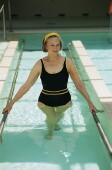
THURSDAY, Dec. 12, 2013 (HealthDay News) — Exercise might help breast cancer survivors relieve the joint pain that is a side effect of their medications, researchers say.
A new study included patients who were taking aromatase inhibitor drugs, such as Arimidex (anastrozole), Femara (letrozole) and Aromasin (exemestane). Five years of treatment with these drugs is recommended for survivors who had stages 1, 2 or 3 hormone receptor-positive breast cancers. This form of the disease accounts for nearly 70 percent of newly diagnosed breast cancer cases.
Nearly half of those who take these medications, however, experience joint pain and stiffness. These side effects are the most common reason patients stop taking the drugs, the study authors said in an American Association for Cancer Research news release.
In this study, breast cancer survivors who were taking aromatase inhibitors and had joint pain were divided randomly into two groups. One group completed a year-long exercise program while the other group received usual care.
The exercise program involved supervised resistance and strength training as well as moderate-intensity aerobic exercise.
Joint pain decreased 20 percent among women in the exercise group, while those in the usual-care group had no change or slight increases in joint pain, the researchers found. The patients in the exercise group had decreased joint pain regardless of age, cancer stage, how long they had been taking the medications and whether they received chemotherapy, radiation or both.
The study was scheduled for presentation Thursday at the San Antonio Breast Cancer Symposium, in Texas. The data and conclusions should be viewed as preliminary until published in a peer-reviewed journal.
“These results are a promising first step in developing [therapies] that can improve aromatase inhibitor-associated joint pain and, in turn, [medication] adherence, breast cancer survival and quality of life,” study author Melinda Irwin, an associate professor of chronic disease epidemiology at the Yale School of Public Health, said in the news release.
The next step is to determine how exercise helps relieve pain in these patients, such as through reducing weight or inflammation, or increasing muscle strength, said Irwin, who is also co-leader of the Cancer Prevention and Control Research Program at the Yale Cancer Center.
More information
The American Cancer Society outlines what happens after breast cancer treatment.
Copyright © 2025 HealthDay. All rights reserved.

